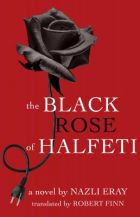Buy or gift a stand-alone digital subscription and get unlimited access to dozens of back issues for just £18.99 / $18.99 a year.
Please register at www.exacteditions.com/digital/cornucopia with your subscriber account number or contact subscriptions@cornucopia.net
Buy a digital subscription Go to the Digital Edition‘The Black Rose of Halfeti’ by Nazlı Eray, trans. Robert Finn
Nazlı Eray’s novel The Black Rose of Halfeti opens with an unsolicited love letter from an 80-something-year-old doctor to his neighbour’s friend, and she is our unnamed protagonist through that action’s fallout. “I’m struggling… inside that murky, sticky, thick spider web into which I have tumbled,” she informs us, and as she tries to make sense of her own reaction to the illicit letter and her own desires, we follow her through a maze of subconscious that jumps from a hotel in Mardin to 1940s Izmir to a tea house in Ankara to the dream geography of Luis Buñuel.
This is a book of magical realism that forgets the realism part. Almost immediately, the narrative is untethered from any anchor of reality, leaving the reader constantly off-balance. The novel functions in a state of sustained dream logic, where even sane characters who seem as though they should be aware of the real world end up willing participants on the rollercoaster of unreality. When a literal dream woman, the Black Rose of Halfeti, appears as a sort of Virgil to our protagonist’s Dante, it barely registers as an unusual occurrence
“Nothing that exists ever disappears,” says our protagonist. This could be the theme of the novel. Impossible scenarios combine the past with the present day, as though the past never left. She meets the ancient Persian king Darius, who is unstuck from time, delighting in the magic of television in the ruins of his Mardin castle, and attempting to woo an ageing Turkish chorus singer with egg-sized diamonds. The Spanish surrealist film director Buñuel and his actress Silvia Pinal have a habit of dropping in to the protagonist’s hotel room without warning to chat about life and drink rose sherbet, while she never blinks at these supernatural intrusions. At one point she timetravels back to post-war Izmir, promptly breaking her ankle and encountering her letter-writing doctor admirer in the bloom of his youth.
These temporal leaps and the return of long-dead historical figures emphasise the characters’ obsession with time and its potential to be malleable. The doctor, holed up in an Ankara tea room with fellow geriatrics after escaping from his apartment, listens to his friend Hıfzı Bey bemoan the years he’s wasted and propose taking them back. “It’s as though I didn’t live for fifteen years. If they give those years back to me, I’d be sixty-nine years old. I’d be really young!” Everyone is trying to escape, whether from their own infirmities or an unexpected letter; the old men in the tea house, not content only to escape from their homes, want to escape from the ravages of time itself.
Uniting all these disparate magical threads is the seductive Black Rose of Halfeti, who emerges from her namesake flowers to spend her nights visiting other people’s dreams. She takes our protagonist along on these nightly journeys – a sort of subconsciousness-tourism that lets the main character learn the inner workings of both the real people in her life (the doctor) and the fantastic friends who surround her (Bunuel) – and by extension, her own feelings.
This book takes delight in its study of tumultuous meditation. The protagonist’s descent into other people’s dreams and sweet interactions with impossible characters make for light and enjoyable reading. I only wish we had more of a chance to see the contrast between her stable world and her internal unravelling, instead of meeting her in the motion of her madness. The book’s opening with the instigating letter gives us no chance to find our feet, and we have little sense of any universe outside her fantasies. The signposts are real, but the route past them buzzes with illusions and hallucinations, fanciful leaps of thought and impossible transfigurations. It’s a journey through a scattered subconscious, joyful in its surreal inventiveness, but never quite finding its way to the conscious world.
An exciting new spirit of creativity is flourishing in Yeldeğirmeni – once a place of windmills and construction workers. But will this vibrant neighbourhood of Kadiköy be able to maintain its delicate balance of old and new? Katie Nadworny reports. Photographs by Monica Fritz
Today a ghost town in the middle of nowhere, a thousand years ago Ani was a bustling commercial city where East and West converged. By Robert Ousterhout. Photographs by Brian McKee
No wonder Aphrodisias was the Emperor Augustus’s favourite city in Asia. Famed for its exquisite sculpture and unsullied surroundings, for Patricia Daunt it is the most beautiful site in the classical world
In a chilly spring the apricot trees of Cappadocia were frothing with white blossom. By early summer the boughs would be heavy with fruit, to be eaten fresh from the branch, dried in the sun – or made into conserves like bottled sunshine for the cold winter months.
After a road trip like no other, taking in many of the best of Turkey’s burgeoning wineries, Kevin Gould and the Cornucopia tasting panel raise a glass (or several) and recommend the best of an impressive bunch
Peter Alford Andrews and his late wife, Mügül, set out to catalogue the traditional yurt – the ultimate portable dwelling. It became their life’s work.


Cornucopia works in partnership with the digital publishing platform Exact Editions to offer individual and institutional subscribers unlimited access to a searchable archive of fascinating back issues and every newly published issue. The digital edition of Cornucopia is available cross-platform on web, iOS and Android and offers a comprehensive search function, allowing the title’s cultural content to be delved into at the touch of a button.
Digital Subscription: £18.99 / $18.99 (1 year)
Subscribe now